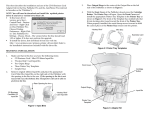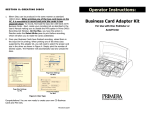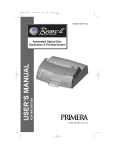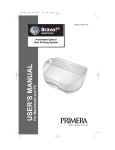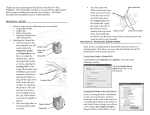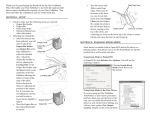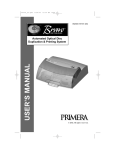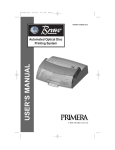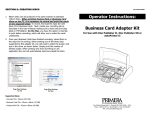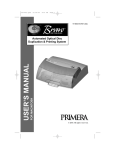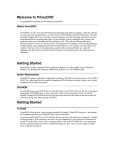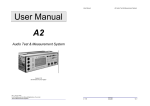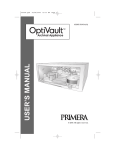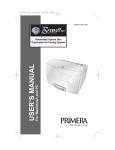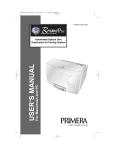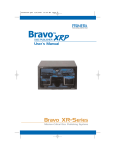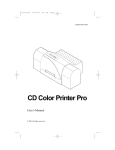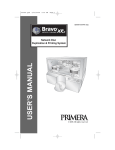Download USER`S MANUAL - Virtual Vision
Transcript
510930.qxd 8/21/2006 10:20 PM Page i 082206-510930-(04) USER’S MANUAL Automated Optical Disc Duplication & Printing System © 2006 All rights reserved. 510930.qxd 8/21/2006 10:20 PM Page ii Notices: The information in this document is subject to change without notice. NO WARRANTY OF ANY KIND IS MADE WITH REGARD TO THIS MATERIAL, INCLUDING, BUT NOT LIMITED TO, THE IMPLIED WARRANTIES OF MERCHANTABILITY AND FITNESS FOR A PARTICULAR PURPOSE. No liability is assumed for errors contained herein or for incidental or consequential damages in connection with the furnishing, performance, or use of this material. This document contains proprietary information that is protected by copyright. All rights are reserved. No part of this document may be photocopied, reproduced, or translated into another language without prior written consent. Trademark Acknowledgments: Windows is a registered trademark of Microsoft Corporation. All other trademarks are the property of their respective owners. Printing History Edition 1.4, #082206, ©Copyright 2006, All rights reserved. FCC Compliance Statement: This device complies with part 15 of the FCC rules. Operation is subject to the following two conditions: (1) this device may not cause harmful interference, and (2) this device must accept any interference received, including interference that may cause undesired operation. For Users in the United States: This product is intended to be supplied by a UL listed Direct Plug-In Power Supply marked "Class 2"or a UL listed ITE Power Supply marked "LPS" with output rated 12VDC, 4.5A or higher. This equipment has been tested and found to comply with the limits for a Class B digital device, pursuant to Part 15 of the FCC Rules. These limits are designed to provide reasonable protection against harmful interference in a residential installation. This equipment generates, uses, and can radiate radio frequency energy and, if not installed and used in accordance with the instructions, may cause harmful interference to radio communications. However, there is no guarantee that interference will not occur in a particular installation. If this equipment does cause harmful interference to radio or television reception, which can be determined by turning the equipment off and on, the user is encouraged to try to correct the interference by one or more of the following measures: • Re-orient or relocate the receiving antenna. • Increase the separation between the equipment and receiver. • Connect the equipment into an outlet on a circuit different from that to which the receiver is connected. • Consult the dealer or an experienced radio/TV technician for help. Use of shielded cables is required to comply with the Class B limits of Part 15 of the FCC Rules. You are cautioned that any changes or modifications not expressly approved in this manual could void your authority to operate and/or obtain warranty service for this equipment. For Users in Canada: This digital apparatus does not exceed the Class B limits for radio noise for digital apparatus set out on the Radio Interference Regulations of the Canadian Department of Communications. Le present appareil numerique n'emet pas de bruits radioelectriques depassant les limites applicables aux appareils numeriques de la class B prescrites dans le Reglement sur le brouillage radioelectrique edicte par le ministere des Communications du Canada. Note: To ensure the unit operates within FCC limits, the power supply should be kept at least 10 cm away from the metal case. CAUTION! TO PREVENT FIRE OR SHOCK HAZARD, DO NOT EXPOSE THE UNIT TO RAIN OR MOISTURE. TO REDUCE THE RISK OF ELECTRIC SHOCK, DO NOT REMOVE EXTERIOR PANELS. NO USER-SERVICEABLE PARTS INSIDE. REFER SERVICING TO QUALIFIED SERVICE PERSONNEL. OPERATE THE UNIT WITH ONLY THE PROPER ELECTRICAL SPECIFICATIONS AS LABELED ON THE PRINTER AND AC ADAPTER. CAUTION! THIS PRODUCT CONTAINS A LASER DIODE OF A HIGHER CLASS THAN 1. TO ENSURE CONTINUED SAFETY, DO NOT REMOVE ANY COVERS OR ATTEMPT TO GAIN ACCESS TO THE INSIDE OF THIS PRODUCT. REFER ALL SERVICING TO QUALIFIED PERSONNEL. THE FOLLOWING LABEL APPEARS INSIDE YOUR UNIT: CLASS 1 LASER PRODUCT LASER KLASSE 1 CAUTION! USE OF CONTROLS OR ADJUSTMENTS OR PERFORMANCE OF PROCEDURES OTHER THAN THOSE SPECIFIED HEREIN MAY RESULT IN HAZARDOUS RADIATION. ii 510930.qxd 4/4/2006 9:36 AM Page iii INDEX Table of Contents Section 1: Getting Started ...............................................................................1 A. Choosing a Good Location ................................................................1 B. Unpacking and Inspection.................................................................1 C. Identifying the Parts ...........................................................................2 D. PC System Requirements...................................................................4 E. MAC System Requirements ..............................................................4 F. Overview of Operation ......................................................................5 Section 2: Hardware and Software Set-Up .................................................8 A. Installing the PC Software .................................................................8 B. Installing the MAC Software.............................................................8 C. Hardware Setup ..................................................................................9 Step 1: Applying Power .....................................................................9 Step 2: Loading Media .......................................................................9 Step 3: Installing Ink Cartridges .....................................................10 Step 4: Connecting the USB Cable..................................................11 Section 3: Creating Discs on a PC...............................................................14 A. Setting up the Publisher’s Printer Driver .....................................14 B. Using SureThing ...............................................................................20 C. Using Other Graphics Programs ....................................................23 D. Using PrimoDVD to Create Your Discs.........................................23 E. Using Kiosk Mode ............................................................................26 F. Copying a CD or DVD .....................................................................27 Section 4: Creating Discs on a MAC ..........................................................30 A. Printed Label Format Requirements ..............................................30 B. Printing Only .....................................................................................31 C. Using Discribe 5.3 .............................................................................31 D. Queuing Jobs .....................................................................................45 E. Printer Options ..................................................................................49 F. Configuration Utility ........................................................................53 iii 510930.qxd 4/4/2006 TOC 9:36 AM Page iv INDEX Section 5: Interpreting the Publisher’s Indicator Lights........................57 Section 6: Maintenance and Troubleshooting ..........................................58 A. Cleaning the Publisher .....................................................................58 B. Performing a Robotic Self-Test ........................................................58 C. PC Software Test................................................................................59 D. MAC Software Test ...........................................................................60 E. Cleaning the Ink Cartridges ............................................................61 F. Technical Support..............................................................................61 Section 7: Technical Specifications .............................................................62 Index..................................................................................................................63 iv Interactive.qxd 9/6/2005 3:30 PM Page 1 Interactive Feature in this PDF Document There are interactive features that will allow you to jump to different locations within the document. Each listing in the Table of Contents is interactive. Place the cursor on either the words or the page number. A small hand with a pointing finger icon appears. Click on the line with the icon and the document will jump to that page. If you want to return to the Table of Contents, move the icon to the top of the page and click on the arrow marked TOC. Navigating through the Index is similar. Place the icon on one of the listings or page numbers, click on it, and it will move to that page. The text relating to the Index listing will appear in red. Returning to the Index can be done by clicking on the arrow marked Index. 510930.qxd 4/4/2006 9:36 AM Page 1 INDEX TOC Section 1: Getting Started THANK YOU… ...for purchasing the BravoTM XR. Bravo XR is the perfect allin-one solution for producing professional looking CD-R and DVD-R discs. NOTE ON TERMS AND CONVENTIONS: From this point forward, the following terms and conventions will apply: The Bravo XR will be abbreviated simply as the Publisher. Optical discs, which can include many different types of discs including CD-Rs, CD-RWs, DVD-Rs and more are all referred to as CDs or discs. A. CHOOSING A GOOD LOCATION • • Place the Publisher in a location with adequate air circulation to prevent internal heat build up. Do not place the Publisher near heat sources such as radiators or air ducts, or in a place subject to direct sunlight, excessive dust, mechanical vibration or shock. B. UNPACKING AND INSPECTION While unpacking your Publisher, inspect the carton to ensure that no damage has occurred during shipping. Make sure that all supplied accessories are included with your unit. The following items should be included: • • • • • • • • • Optical Disc Publisher Gray Plastic Input and Output Bins (Located inside the cardboard insert) Switching Power Supply with Power Cord One Three-Color (CMY) Ink Cartridge One Monochrome Black Ink Cartridge QuickStart Installer Disc USB 2 Interface Cable (Beige) Warranty Card This Operator's Manual, Quick Start Guide and Other Printed Information Getting Started 1 510930.qxd 4/4/2006 9:36 AM Page 2 INDEX TOC Save the carton and packing materials. They will come in handy later if you ever need to transport the Publisher and/or any of its parts and accessories. C. IDENTIFYING THE PARTS Front Panel and Top This illustration shows the Publisher, its Control Panel, Buttons, LED indicator lights, Input and Output Bins and other components. Ink Cartridge Carrier Input Bin Ink Cartridge Button Output Bin Control Panel Robotic Disc Transporter Power Button Front Cover LED Status Lights Color Ink Cartridge Monochrome Black Cartridge Control Panel Lock Reject Area CD/DVD Recorder CD Tray Button The Robotic Disc Transporter moves discs from the Input Bin, to a CD/DVD Recorder, to the printer, and finally to the Output Bin. The CD/DVD Recorder is automatically loaded and unloaded by the Publisher’s Robotic Disc Transporter. The Recorder Tray Button manually opens or closes the Recorder Tray. In normal operation, the in/out movement of the Recorder Tray is controlled automatically and this button is not used. 2 Getting Started 510930.qxd 4/4/2006 TOC 9:36 AM Page 3 INDEX The Control Panel contains LED Status Lights and Buttons to control the Publisher. The right LED Status Light indicates that Power is ON. The left LED Status Light is on to indicate that the cover is closed. They also blink in certain patterns to indicate an error or other condition of the Publisher. See Section 6 for a full explanation of the LED Status Light conditions. The Power Button turns the Publisher's power OFF if pressed and held for five seconds. Press it quickly to turn power back on. When already powered on quickly pressing the power button will move the arm to the right or the middle to allow access to the recorder drive or the bins. When the front cover is opened, the Ink Cartridge Button is used to position the Cartridge Carrier for easy ink cartridge replacement. When the front cover is closed, pressing the Ink Cartridge button will open or close the Printer Tray. (Must override cover lock sensor to simulate cover closed condition) The Input/Output Bins are situated under the top cover of the Publisher. The bins will hold up to 25 discs. The right-side bin is the Input Bin for blank media; the left-side bin is the Output Bin for finished discs. The Reject Area is where discs are dropped if they do not pass a software verification test. The discs slide down the ramp out in front of your Publisher. The Front Cover is a durable plastic cover that will protect the Publisher from dust and interference. The Ink Cartridge Carrier holds both a color ink cartridge (left-side pen) and a monochrome ink cartridge (right-side pen). Getting Started 3 510930.qxd 4/4/2006 9:36 AM Page 4 INDEX TOC Rear Panel This illustration shows the input ports found on the rear panel of the Publisher: USB 2.0 Port Power Input Port The USB 2.0 Interface is connected to an open USB 2.0 port on your PC with the USB 2.0 cable, included with your Publisher. The Power Input Port connects to the included 100V~240V 12V switching power supply. D. PC SYSTEM REQUIREMENTS Before getting started, it is important for you to verify that your PC meets the minimum system requirements. Here's what you need in order to successfully copy discs at 8x or above with the PrimoDVD 2.1 software: • 700 MHz or faster Pentium III/IV processor running Windows 2000 or XP. • 512 MB or greater RAM • Free hard drive space of at least 10 GB. • Available USB 2.0 Port. If your PC does not have at least these minimum system requirements, system performance may not be acceptable. E. MAC SYSTEM REQUIREMENTS Before getting started, it is important for you to verify that your computer meets the recommended system requirements. Here's what you need in order to successfully burn and print with the Discribe software: • G4 PowerPC 700MHz or higher running OS X version 10.2 or higher • 256MB RAM 4 Getting Started 510930.qxd 4/4/2006 9:36 AM Page 5 TOC INDEX • Free hard drive space of at least 2 GB (up to 6 GB for DVD) • Available USB 2.0 Port • Do not connect the Bravo to any USB hubs or the USB port on your keyboard. It should be connected directly to an onboard USB 2.0 port. If your computer does not have at least these minimum system requirements, system performance may not be acceptable. F. OVERVIEW OF OPERATION Your new Publisher is an automated, precision device intended for continuous-duty publishing of discs. The following is a description of the complete process of duplicating and printing a CD/DVD job on your Publisher XR (See section 5F for Overview of Operation in backup mode): 1. Up to 25 blank discs may be loaded at one time into the Input Bin. 2. The Publisher's integrated Robotic Disc Transporter will first check your recorder drive for a disc by attempting to "pick" from the recorder. Then, the Robotic Disc Transporter will pick a disc from the Input Bin. 3. The Recorder Tray opens automatically and the Robotic Disc Transporter places a disc into the recorder. Getting Started 5 510930.qxd 4/4/2006 9:36 AM TOC 4. Page 6 INDEX The Recorder Tray then automatically shuts. Robotic Disc Transporter will automatically check the Input Bin to make certain that only one disc was picked. Through software control, you can perform a test on each disc before recording. If a disc does not pass (meaning that all or part of that disc is not recordable), the Robotic Disc Transporter picks it out of the CD Tray and sends it to the Reject Area. 5. The Recorder is now writing to the disc. If you were to fully record a CD with data, audio, video or music (650 MB), recording time is about 3 ½ minutes each. A full DVD records in about 10 minutes. Most jobs don't fill the entire disc, so recording time is usually less than this. After recording, the Recorder Tray opens automatically. The Robotic Disc Transporter will lift the disc out of the Recorder Tray. The Recorder Tray will close, and the Printer Tray will open. The Robotic Disc Transporter will lower the disc into the Printer Tray, and the Printer Tray will then automatically close. 6. If publishing more than one disc, the Robotic Disc Transporter will load the Recording Drive with a blank disc from the Input Bin to start recording the next round. 7. Once recording has started on the next round, printing will start with the recorded disc from the previous round. This simultaneous printing and recording greatly increases the throughput of your Publisher. 6 Getting Started 510930.qxd 4/4/2006 TOC 9:37 AM Page 7 INDEX 8. Print time varies according to which print mode has been selected (section 3-A). In most cases, print time takes no more than 2 minutes. After printing the first disc, the Publisher's Printer Disc Tray opens automatically. The Robotic Disc Transporter moves the finished disc to the Output Bin. 9. The process starts over and repeats until all blank discs are gone or the number you have specified via software are copied and printed. 10. Now that you understand the order of operation, it is time to set up your Publisher. Getting Started 7 510930.qxd 4/4/2006 9:37 AM Page 8 TOC INDEX Section 2: Hardware and Software Set-Up This section will describe the step-by-step process of setting up your Publisher. This includes information on how to load the supplies (ink and disc media) necessary to start producing discs. A. INSTALLING THE PC SOFTWARE The Installer Disc has a QuickStart menu that will guide you through the process of setting up your Publisher. Please refer to the following for more information on each step: 1. 2. Place the Optical Disc Publisher Installer CD in your CDRom Drive. The Installer application should automatically launch in a few moments. If it does, proceed to Step 2. If it does not automatically launch, follow these steps: • Double-click the My Computer Icon, then double-click the icon of the appropriate CD drive containing the Software Installer disc • Double-click Installer.exe In the Installer Application, click the QuickStart Install button. The QuickStart Install will guide you step-by-step through the installation process. As you complete each step, click Next. Steps 1-4 are shown in section D below as well as on the monitor. You may follow either to complete the setup. B. INSTALLING THE MAC SOFTWARE Before installing Discribe please note that all software must be installed on a hard disk. Once you have installed the software, store the original program CD-ROM in a safe place. Please note that your user account must have administrative rights to properly install a new printer. You can check with your system administrator or check with Apple support to confirm whether or not your account has administrative rights. Install the software as follows: a. Insert the Bravo Installation CD-ROM in your system's CD-ROM drive. 8 Hardware and Software Set-Up 510930.qxd 4/4/2006 9:37 AM Page 9 INDEX TOC b. Double-click the CD-ROM icon. c. Double-click on the Installer.mpkg file icon. Follow the on-screen instructions. d. The volume containing the operating system should be selected for installation. Click the Continue button. All components will be installed to their proper locations. e. Once the installation has completed, click Quit. You have successfully installed all the necessary software! Section C below will describe how to connect the Bravo to your Mac. C. HARDWARE SETUP To connect your new publisher, please do the following: Be sure you have removed the packing tape and cardboard insert prior to applying power. Step 1: Applying Power • • • Locate the power adapter supplied with your Publisher. Place one end of the adapter cord into the power port on the rear panel of the Publisher. Unit will initialize for approximately 30 seconds. Step 2: Loading Media (Discs) NOTE: Your Publisher can print directly onto virtually any brand of printable-surface CD/DVD media. However, different brands of discs have different printable coatings. Because of this, you may need to adjust the printer driver settings to accommodate your specific brand of CD/DVD media. Refer to Section 3A or 4E for further printer driver information. Due to the wide variety of printable-surface CD/DVD media, you may find that certain brands of discs provide higher print quality than others. For maximum print quality, use CD/DVD media authorized by Primera. Hardware and Software Set-Up 9 510930.qxd 4/4/2006 9:37 AM Page 10 TOC INDEX Refer to the following steps when loading discs in to the Publisher: • Open the front cover of the Publisher • The Publisher will automatically position the cartridge carrier and Robotic Disc Transporter to the center position allowing for easy access to the bins. • Load the Input Bin (the bin located on the right-hand side of the Publisher) with 25 blank discs and place the bins on the mounting pegs. Step 3: Installing Ink Cartridges • Press the Ink Cartridge Button to move the Ink Cartridge Carrier to the load position and open the ink cartridge covers • Remove each ink cartridge from its packaging 10 Hardware and Software Set-Up 510930.qxd 4/4/2006 9:37 AM Page 11 INDEX TOC • Slowly remove the tape covering the cartridge's print head, being careful to avoid damaging the barcode label on the underside of the cartridge. DO NOT TOUCH THE COPPER AREA! • Insert the ink cartridges into the carrier, copper end first and snap the cartridge cover in place. Insert the color in the left holder, monochrome black in the right cartridge holder. Color Black Pull out and lift up • Close the Publisher’s front cover. Step 4: Connecting the USB 2.0 Cable Connect the Publisher to your computer with the beige USB 2.0 Cable. Hardware and Software Set-Up 11 510930.qxd 4/4/2006 9:37 AM Page 12 TOC INDEX If you are using Windows, after a few moments a found new hardware wizard will appear. Select "Install the software automatically" and click Next. Make sure that you have your installation disc in a drive on your computer. You may see a notice like the one shown below stating that the device has not passed Windows Logo Testing. Click Continue Anyway to continue installing the printer driver for your Publisher. If you are using a MAC you may be required to Add the printer via the Printer Setup Utility. 12 Hardware and Software Set-Up 510930.qxd 4/4/2006 TOC 9:37 AM Page 13 INDEX 1. Open the Printer Setup Utility located in the Applications Utilities folder. 2. Click Add. Select the Disc Publisher XR from the list of available printers. Click Add again. Hardware and Software Set-Up 13 510930.qxd 4/4/2006 9:37 AM TOC Page 14 INDEX Section 3: Creating Discs on a PC There are two main components to creating discs, printing and burning. SureThing CD Labeler is used to design the printing on your discs. PrimoDVD 2.1 controls the recording and allows you to select the image to be printed to your discs. Both applications will be described in detail in this section. A. SETTING UP THE PUBLISHER'S PRINTER DRIVER Once the Publisher software has been successfully installed, you will want to take a moment to familiarize yourself with the printer driver settings for your Publisher. These settings affect the print quality of your discs. The default settings of the Publisher printer driver will fit most printing needs. Please refer to the following steps to change or verify your printer driver options: 1. Click the Start button. For Windows 2000 point to Settings and click on Printers. For XP Professional click on Printers and Faxes. For XP Home click on Control Panel, then click on Printers and Other Hardware, then click on Printers and Faxes. Click on the Disc Publisher XR icon with the right mouse button and select Printing Preferences. 14 Creating Discs on a PC 510930.qxd 4/4/2006 TOC 9:37 AM Page 15 INDEX NOTE: Most applications allow you to change these same printer driver options from their "Print" and/or "Printer Setup" screens. This means that you don't have to go back to the main printer setup window each time you want to change a setting or option in the printer driver. These applications will usually give you the same choices and options, but in a slightly altered format. Some applications do not save your printer driver option changes, but instead only use your changes for the current image. Paper Size The paper size option will be set to CD for printing onto printable surface CDs and DVDs. Resolution Select the appropriate print quality option for your image. Keep in mind that Normal 600 provides the lowest quality but fastest print, and that Ultra Photo 4800 provides the highest quality but slowest print. You may wish to experiment with these options to see which one is best for your particular CD media and print quality requirements. Cartridge Type The Print Black with Black Cartridge setting will print discs using both the color and black cartridges. This saves color ink by using just the black cartridge for the black areas of your design. When using this setting, be sure to perform the Alignment Calibration print described later in this section. Please note that the Calibration Alignment will need to be done after installing a new cartridge as alignment may vary from one cartridge to the next. Select Color to print using only the color cartridge. The Monochrome Black setting prints using the Monochrome Black cartridge only. Color Matching Click on the Color Matching down arrow and choose the color matching option that's right for you. Select None if you are more interested in print speed rather than color accuracy, if you have already color corrected your image for printing, or if you are using some other third party color matching software. Select Algebraic if you would like the printer driver to make very simple color balance adjustments based on an RGB color model. This option gives you more natural looking images without actually utilizing any specific color matching software. Creating Discs on a PC 15 510930.qxd 4/4/2006 9:37 AM Page 16 INDEX TOC Select PrimaColor to enable color-matching profiles written specifically for the Publisher by Candela Color Management System. This setting automatically adjusts the color of your image according to predetermined printer profiles and default system profiles. This results in a very precise color match when attempting to print photographic images. Select Z-Color to use a factory set color matching scheme that is calibrated toward images that have photographic qualities. Ink Saturation This option controls the ink saturation of the printed image. When printing onto the printer manufacturer's TuffCoat CD media, this option can be left at its default setting of 50%. When printing onto other brands of printable CD media, you may need to adjust this control in order to optimize the ink saturation for the printable surface of your specific CD media. Click on the up and down arrows to change the ink saturation setting. Lower numbers reduce the overall ink saturation, while higher numbers increase it. Please note that higher ink saturation results in higher ink usage. This will reduce the amount of discs produced per cartridge. Inner Diameter This value changes the size of the non-printed center. Larger numbers cause the non-printed center to be larger and smaller numbers make the non-printed center smaller. This number is incremented by 0.1mm so a change of 10 for inner diameter changes the diameter by 1mm. Inner Diameter Non-Printed Diameter 386 1.518” (38.6mm) (TuffCoatTM, Default) 150 0.591” (15mm) (Physical Center) Centering Test Print NOTE: Your printer comes from the factory pre-calibrated to print the image in the center of the CD. You can use this adjustment if you need to fine-tune this location. If you ever wish to verify your factory-calibrated Vertical and Horizontal calibration settings, you can run a simple calibration procedure to assure that your images will be centered when printed on a CD. To do this, refer to the following steps: 1. Verify that a disc and a color ink cartridge are installed in the Publisher. It is important to use the same disc you 16 Creating Discs on a PC 4/4/2006 9:37 AM Page 17 INDEX TOC normally use for your publishing because different brands of discs may vary slightly in size. Also, verify that the Publisher is powered ON and that it is connected to your computer. 2. Click on the Centering Properties Test Print button. The printer will begin printing the calibration test print. 3. When the print is complete, rotate disc 180º and put the disc back in the input bin and repeat step 2 using the same disc. 4. When the second run of the print is compete, you should have a test print that looks something like the following: After printing this image once, rotate this CD so the ARROWS point to the BACK of the printer and print again. BACK Vertical Calibration NOTE: 5 4 3 2 1 0 -1 -2 -3 -4 -5 Find and enter the number whose lines tough (must be the SAME number) BACK -5 -4 -3 -2 -1 0 1 2 3 4 5 -5 -4 -3 -2 -1 0 1 2 3 4 5 5 4 3 2 1 0 -1 -2 -3 4 -5 Find and enter the number whose lines tough (must be the SAME number) Horizontal Calibration 510930.qxd 5. Along the Vertical axis of the printed disc, find the number whose lines touch. For example, in the above illustration, the number would be 2. Enter that number into the Vertical box of the Calibration window and 0 would be entered for the Horizontal axis. 6. Select the OK button. Your images should now be centered when printed on a disc. After your selections have been made, close out of the printer setup window. You are now ready to go to an application program and print. All printer driver selections will stay the same until you change them. Creating Discs on a PC 17 510930.qxd 4/4/2006 9:37 AM TOC Page 18 INDEX Enable Ink Low Warning This setting lets you enable or disable the warning from the printer to tell you when the ink cartridges are getting low. Ink Levels and Cartridge Maintenance Select this button to display the current ink levels as well as options for cleaning and changing cartridges. Select Clean button to send a simple test pattern to the printer. Be sure to have a disc in the Bravo's input bin and the front cover closed. The test pattern, shown below, purges ink through nozzles of your ink cartridge to clear any blockages. The test pattern will show if the nozzles require any further cleaning. Clogged Head Needs Cleaning Clogged Head Needs Cleaning Clean Head Functioning Property Clean Head Functioning Properly 18 Creating Discs on a PC 510930.qxd 4/4/2006 TOC 9:37 AM Page 19 INDEX If the Yellow, Magenta, Cyan or Black diagonal lines printed on the disc show breaks, repeat the cleaning procedure. If nozzles still appear to be clogged, remove the cartridge and gently wipe the nozzle area sideways with a clean water-dampened cloth. If after several cleanings a color still does not appear on the test print, the cartridge may be damaged or empty and may need to be replaced. Select the Change button to install a fresh, new ink cartridge or to switch back and forth between previously used cartridges. After the cartridge has been replaced according to the instructions on page 10, Step 3: Installing Ink Cartridges, select either the New Cartridge Installed button or the Old Cartridge Installed button accordingly. These selections are necessary for the printer to accurately keep track of ink cartridge ink levels. Select the Details button for information on the drivers, firmware, alignment and number of discs printed with your Publisher. Disc Output Location This can be set either Normal (Left Bin acts as output), or Kiosk (finished discs deposited out the Front Exit). The default is Normal (Left Bin). Note that this will only have an effect when doing printing only − this will have no affect when recording and printing through PrimoDVD. In PrimoDVD, click Robotics then Options and select Kiosk Mode check box. Creating Discs on a PC 19 510930.qxd 4/4/2006 9:37 AM Page 20 INDEX TOC Enable Bi-di Printing When enabled the Bravo will print bi-directional for faster printing. The default is uni-directional printing. When you enable bi-directional printing, you should perform the Alignment Calibration described later in this section. Please note that the calibration is stored on your computer, so if you move to a new computer you must repeat the calibration. Alignment Calibration The Alignment Calibration allows you you create a test print that will provide you with values to configure your printer for Bi-Di- Printing and to align the color and black cartridges for Color+Black printing. If Bi-Di Printing is enabled, or if you use Color+Black as a cartridge type in the driver settings, it is important to perform this calibration every time you change a cartridge. To print, click the Alignment Calibration Properties button then click Yes.. The print will look like this: A B 0 0 4 8 12 1 5 9 13 2 6 10 14 3 7 11 15 2 4 6 8 10 12 14 2 4 6 8 10 12 14 C 0 D 0 2 4 6 8 10 12 14 B. USING SURETHING The SureThing Disc Labeler software included with your Publisher is a great tool for creating professional looking discs. You can use SureThing's Smart Designs to quickly label a disc, or easily import your own design in many popular file formats. The On-Line Help section will provide complete instructions on all the features in this package. The following is a tutorial on creating a basic disc design: 20 Creating Discs on a PC 510930.qxd 4/4/2006 9:37 AM TOC Page 21 INDEX 1. Click New... 2. Select Disc Publisher / AutoPrinter under Label Products and click Next. 3. Click Browse to look through the many built-in backgrounds included with SureThing, or click Clear if you would like to import your own background or design. Click Next. Creating Discs on a PC 21 510930.qxd 4/4/2006 9:37 AM TOC Page 22 INDEX 4. Check Use Smart Designs to browse through different built-in designs. Deselect this option if you would like to create your own layout. When finished, click Next. 5. Click Finish. You should now see your basic layout. Simply double click on text boxes to modify the standard text with your information. If you want to import your own graphics, click Photos/Clipart to browse for images. Many standard clipart symbols are included with your software. 6. Once you are happy with your design, save it as a SureThing Design (*.STD) format. 7. Close SureThing CD Labeler. For optimal performance, SureThing CD Labeler must not be running when you are publishing discs in Primo DVD 2.1. To print only from SureThing, simply open the file menu and choose print. Select the printer as Disc Publisher XR. Choose the number of copies and click OK. 22 Creating Discs on a PC 510930.qxd 4/4/2006 9:37 AM Page 23 INDEX TOC C. USING OTHER GRAPHICS PROGRAMS While SureThing will handle most labeling needs, some people prefer to use other graphic programs. Because of this we offer the flexibility to create print files (*.PRN) from any application. Your Publisher will support two types of print files in PrimoDVD 2.1: • • *.STD - SureThing CD Labeler *.PRN - Print files created through the Publisher Printer Driver *.STD files As described earlier, these are files created in SureThing CD Labeler. This is the recommended file type for printing as it offers the most flexibility. .PRN files These are files created from virtually any Windows graphics application. Instead of printing to a printer, you print to file. In some programs, you can print directly from that software's Print screen, through the correct printer driver software for the brand and model of printer you've installed on your Publisher, to a *.prn file. Adobe Illustrator and CorelDRAW! are examples of such programs. Most of the popular, higher-end graphics applications give you this option of printing directly to a file. If your graphics software does not allow a direct print to a file, you will need to go into your Windows Control Panel, Printers where you will be able to select File from your list of available printer ports. This will enable the driver to print to a PRN file from any application. Note: You must change the port back to the USB port before you can print. D. USING PRIMODVD TO CREATE YOUR DISCS Now that you have a design for your disc, you are ready to publish. The example given in this chapter is for a simple audio CD copying job using PrimoDVD software. Please refer to the Help file accessible from Primo's Help Menu for further information on recording discs. Creating Discs on a PC 23 510930.qxd 4/4/2006 9:37 AM Page 24 TOC INDEX Operating Screens To keep things simple, there is really only one main operating screen you'll need to know about in order to run the PrimoDVD Software. It is called the Application Window and it looks like this: Drive Status Window Job Set-Up Window Job Status Window Under this window there are several adjustable-size windows that indicate what you've set-up and what's happening: the Drive Status Window, the Job Status Window, and the Job Setup Window. A sub-Window called the Activity Log is also available, but it is hidden upon initial boot-up of the software. Here's a short explanation of each Window: • • Drive Status Window. Lists all of the available drives for your computer. Usually, your configuration has just two drives: the internal drive in your PC and the CD Recorder installed in your Publisher. Job Set-Up Window. This is the space where the Job Setup Panel for each job is displayed. When you select a job by clicking on File: New from the File pull-down menu, a different type of Job Panel will appear in the Job Set-Up Window depending upon the type of job selected. Each Job Panel contains all of the necessary information to run that job, including source file name, number of copies to make, etc. In addition, the Job Panels report status information during the running of the job. 24 Creating Discs on a PC 510930.qxd 4/4/2006 9:37 AM Page 25 TOC INDEX Job Status Window. As each Job Panel is formed, an entry is made in the Job Status Window at the lower left side of the main Application Window. When jobs are started, this list displays the status of each job, including the number of discs copied and the number remaining. This window may be hidden by clicking on the Show Job List Panel under the View menu. One other sub-window available is called the Activity Log Panel. It records all user actions and system responses during the recording process by time of occurrence. If a problem occurs while you're not present in front of the computer, you can browse the log to find out details that may no longer be present on the main screen. The Log may be viewed by clicking on View: Show Log. The log may be saved (this happens automatically every time you exit the software). Emptying the log will delete all entries permanently. • Overview of Recording Three basic recording operations are available: (1) actual recording, (2) test recording, and (3) verifying. Actual recording is self-explanatory. Discs will be recorded without any testing beforehand. If you have used the Publisher successfully before with a particular brand of media that is highly reliable, you may choose to record without testing or verifying. This will deliver the highest throughput rate of finished discs. Test recording performs all of the operations of recording with the drive's laser turned on to reading power. A test recording run will determine if the data source will keep up with the recorder's demand. Verifying will compare the data recorded to the original data. This ensures that the recorded data exactly matches the original. Note that is will take about twice as long to Record and Verify as compared to just Record. All discs that do not verify properly will be rejected. Please note that if Verify is not enabled, Primo will still reject discs that record improperly. The Verify feature simply double checks the record job to compare that the copy and master contain the same information. Creating Discs on a PC 25 510930.qxd 4/4/2006 9:37 AM Page 26 INDEX TOC After your job(s) have been set up, each one may be started by clicking on the red "Record" button at the top of the Job Setup Panel. Here's what the Job Setup Panel looks like: Record Pause Stop While jobs are running, they may be paused or stopped by clicking on the appropriate buttons on the Job Setup Panel. The Pause Button will allow the current recording to finish, then suspends operations on that job. Recording is resumed by clicking the Pause button again. The Stop Button will abort any recording in progress and cause the Publisher to transport the disc to the Reject Area. It will also terminate that job. Record, Stop and Pause actions for the currently selected (highlighted) job may also be selected from the Toolbar at the top of the main Application Screen. Once a job is started by pressing the Record button, other subsequent jobs can be created in the same manner and queued by pressing the Record Button. These jobs will appear in a queue in the Job Status Window. Primo can queue up to 64 unique jobs. E. USING KIOSK MODE Kiosk Mode allows you to use both of Bravo's Bins as input, doubling your disc capacity from 25 discs to 50 discs. In this mode, the finished discs will be deposited out through the front "reject area" of the Bravo. In Kiosk mode all discs would be ejected in this manner. Rejects can be identified in the stack because they will not be printed in the same manner as successfully recorded discs. Primera Technology offers an optional Kiosk Mode Kit that contains a third output bin to 26 Creating Discs on a PC 510930.qxd 4/4/2006 9:37 AM Page 27 TOC INDEX collect the discs. This optional bin attaches to the front of the Bravo. This kit is available through your reseller. Kiosk mode is enabled as follows: 1. In PrimoDVD 2.1 click Robotics then Options from the main menu. 2. In the Options dialog box, check the option labeled Enable Kiosk Mode. 3. If you would like the Bravo to physically print the word "Reject" on rejected discs, select the Print "Reject" option. Otherwise, rejected discs will simply be ejected with no printing at all. F. COPYING A CD OR DVD Now, you're ready to start an actual recording job. In this example, we'll perform a simple disc to disc copy. More detailed information regarding other types of jobs (data discs, Audio CD, etc.) can be found in the Primo DVD Help files under the Help Menu - Get Help. Disc to Disc copy can be used to copy any CD or DVD master. This job type reads the master disc from a specified CD/DVD drive on your system to the hard drive of your computer. (This assumes you have checked "Make a temporary image on Creating Discs on a PC 27 510930.qxd 4/4/2006 9:37 AM TOC Page 28 INDEX hard drive and copy from there") The master is stored in the Primo Global Image format (*.gi) in a temporary location on your computer. Primo uses this temporary file to make all subsequent copies that are requested. The master disc is read only once to create the initial temporary GI file. Disc to Disc copy is Recommended for all CD or DVD types (Audio CD, Data CD, Software Install Disc, Video CD, DVD, DVD-ROM, etc.). Step 1 - Select File - New Job - Disc-to-Disc Copy or Select Disc to Disc Copy from the Primo Starter Window. A copy job setup panel will be created in the job setup window. Step 2 - Select the drive you will use for the reader: right-click on the desired drive (listed in the drive status window) and choose Select/Deselect as Reader from the menu. A bluish green arrow pointing to the right indicates a selected reader drive for a job. Drive configuration with reader set as computer CD/DVD drive Drive configuration with reader set as Publisher drive - Recommended Step 3 - Select the recorder(s) that will record this job by double clicking the drive in the drive status window. A red arrow pointing to the left indicates a selected recorder drive. (This selection may already automatically be made for you by the software) Step 4 - Select the number of copies and the recording speed. Step 5 - Check the print box if you want to print a label on the disk. Type the full path and name of your image file into the box, or click on the Browse button to open a standard Windows Open dialog to locate the file. If you have not yet 28 Creating Discs on a PC 510930.qxd 4/4/2006 9:37 AM Page 29 INDEX TOC created a label to print on the disc click on the SureThing button to open SureThing and create a label. (Refer to Section 3B for Instructions on how to create a label) Once you close SureThing. The label file will automatically be associated with your job. Step 6 - Check the box next to "Make a temporary image on hard drive and copy from there". This is recommended for all hardware configurations. Failure to check this box may cause a high number of rejected discs. Step 7 - Click on the red Record button Step 1 Step 7 Steps 2 & 3 Step 4 Step 5 Step 6 Note: It is possible to use the drive in the duplicator for the Recorder drive and the reader/source drive. This is recommended to reduce recording variables which are introduced by using different drive models for reading and recording. Creating Discs on a PC 29 510930.qxd 4/4/2006 9:37 AM Page 30 TOC INDEX Section 4: Creating Discs on a Mac There are two main components to duplicating disc, printing and recording. You can use any graphics application to design your label for printing. Discribe 5.2 will allow you to master the data and automate the recording and printing of your discs. This section will describe both of these applications in detail. A. PRINTED LABEL FORMAT REQUIREMENTS Your printer driver allows you to create labels in most any graphics application. The driver will center the image and automatically crop it to the shape of a CD. This means you do not necessarily need a template to create a CD in your favorite graphics program. Simply create a custom page size of 120mm (4.72 inches) square and center your image in that area and the driver will do the rest. The center sizes listed in Section E should guide you in creating your disc. Because the driver crops the image to the shape of a CD, you do not want to make your design round. You will find it is best to "over bleed" your design by filling the whole 120mm area with your image. This ensures the outer and inner diameters will print perfectly round on your disc. Label Format Requirements: • 4.72 x 4.72 (120mm) Square Image. • No Circular Images To Print and burn simultaneously through the Discribe program the image will need to be in one of the following supported file formats: JPEGs, TIFFs, PICTs, PDFs, GIFs, BMP, JPEG 2000, MacPaint, Photoshop, PNG, QuickTime Images, SGI, TGA, and more. In order to help you design your label, included on the installation disc are templates in eps format. These templates will help you get started designing your label. To use the template follow these steps: 1. Open the template in Photoshop or Illustrator. 2. Create a new layer for your image or graphics. (Make sure the template layer is on top of the image layer) 30 Creating Discs on a Mac 510930.qxd 4/4/2006 9:37 AM Page 31 TOC INDEX 3. Place your image or design your graphics on the new layer. Use the template as a guide for image and graphics placement. 4. Before you print or save your image in another format, either hide the template layer or delete the template layer. The circular shape and center cut out should not beprinted. Use it only as a guide to layout your image. B. PRINTING ONLY To print simply follow the normal procedure for printing from your graphics application. Select the Disc Publisher II as your printer. Select the number of copies. The Publisher will pick and print as many copies as you select. C. USING DISCRIBE 5.3 Now that you have a label designed, lets take a look at how to create the data you want recorded to disc. This is done in CharisMac Discribe 5.3. Discribe will allow you to create many types of discs. The following section contains tutorials for four common types of jobs, Data, Audio, Copy and Stream jobs. C.1 Audio 1. Double click the Discribe Icon to launch the program. You will see a splash screen followed by Discribe's Quick Start Menu. Creating Discs on a Mac 31 510930.qxd 4/4/2006 9:38 AM Page 32 INDEX TOC 2. Click the Audio CD button. You will now see the Audio Job Pane. 3. Add your audio tracks by dragging AIFF, MP3, WAV, Sound Designer II (SDII) files or tracks to the window. You can drag one or multiple files to the window in any combination. Files that are in MP3, WAV and SDII file format will need to be converted into a file format that Discribe can use to write to CD. Discribe will prompt you for a save location for these files when they are dragged to the interface. Select the desired location and click the Select "Your Location" button for the conversion to take place. Once the conversion has completed, the newly converted file will be added to your project. 32 Creating Discs on a Mac 510930.qxd 4/4/2006 9:38 AM Page 33 INDEX TOC Note: AIFF Files will need to be in a specific format in order for Discribe to accept them. Please be sure that your hard disk has enough space for the converted files and that the files adhere to the following guidelines: • • • Tip: Stereo 16 Bit 4431 KHz SDII, MP3 and WAV files will be converted into this format, files added from a mounted audio CD do not have to be converted, but can be converted by holding down the Command key when dragging tracks from a mounted audio CD to the interface. Discribe will prompt you to find out where you would like the extracted tracks saved. 4. Click the Audio… button to view the Audio Picker pane. This will show all the tracks that have been added to your current audio project. You can add tracks by clicking the Add... button and navigating to the desired track, or you can remove tracks by selecting them in the Audio Picker window and clicking the Remove button. Sequence your tracks by clicking and dragging the audio track to the desired location within the Audio Picker pane. You can select multiple files in the same way that the Finder's 'List' view works (click and drag or by Shift clicking on multiple files). Discribe allows you to customize the pre-gap, or, the space at the beginning of a track, from 0 to 9 seconds. To set the pre-gap on a track or tracks, select the desired track(s) in the Discribe Audio Picker window and click the pre-gap pop-up menu and select the desired length of time. Note: The first audio track must have a pre-gap of two and is not user definable. By default, Discribe will set the pre-gaps of tracks 2 and higher to 2 seconds. Creating Discs on a Mac 33 510930.qxd 4/4/2006 9:38 AM Page 34 TOC INDEX 5. You may preview audio tracks by selecting the desired track and clicking the Play button. If you are satisfied with the content of your audio project, you are ready to write the disc. If you are still in the Discribe Audio Picker window then click the OK button to return to the main interface. Click the Burn... button to continue. 6. The Robot Write Options window contains selections to help you control the printing of the image, number of discs, recording options and more. Set these options as follows: 34 Creating Discs on a Mac 510930.qxd 4/4/2006 TOC 9:38 AM Page 35 INDEX Kiosk Mode will allow you to increase the capacity of your Bravo from 25 to 50 discs by dispensing finished discs out the front of the unit instead of dropping them to the output bin. This allows you to place blank discs in both the input and output bins doubling your capacity. An optional Kiosk Kit is available from your Primera reseller that contains a custom output bin to catch the finished discs as they leave the Bravo. b. Click the Print Image on Discs button to enable printing. This will enable other buttons in this pane. c. Press the Choose Image button to select an image to print. This will allow you to select any file type Apple's Preview supports including JPEG, TIFF, PICT, PDF, GIF, BMP and more. a. d. YOU MUST CLICK Page Setup and set Format For to Disc Publisher XR! Also set the option to select a paper size as described in Section 4-E of this manual. Creating Discs on a Mac 35 510930.qxd 4/4/2006 9:38 AM Page 36 INDEX TOC e. Print Settings will launch the Printer Driver settings when clicked. These settings are described in detail in section 4-E of this manual. Set Print disc before recording/ Record disc before printing. Record disc before printing is recommended for most jobs to avoid printing on discs that do not burn properly. Print Before Recording is used for jobs involving Hockey Rink or Business Card shaped CD-Rs where it is important to print before recording for proper card alignment. g. If using Kiosk Mode, choose whether or not to Print "Reject" on Bad Discs in Kiosk Mode. When enabled, this will cause a disc that has failed to verify to be printed with the word REJECT prior to being ejected from the publisher to make it easier for bad discs to be identified in the output stack when using the Kiosk Mode. If this option is not enabled, bad discs will be ejected with no printing at all. h. Select the Number of discs requested for this job. i. Stop Job after Number of Writes Fail allows you to decide how many consecutive failures the Publisher will accept prior to canceling a job. Once you have selected your image and chosen your preferred settings in the Robot Write Pane, click Start to begin recording your job. You can queue several different jobs for recording if you like, this option is described in Section 4-E of this manual. f. 7. 36 Creating Discs on a Mac 510930.qxd 4/4/2006 TOC 9:38 AM Page 37 INDEX C.2 Data 1. Double click the Discribe Icon to launch the program. You will see a splash screen followed by Discribe's Quick Start Menu. 2. Click the Data CD button. You will now see the Data Job Pane. Discribe defaults to a Mac HFS format, if you want the disc to be read on a Windows format PC, you will need to select ISO/9660 as your job type from the drop-down list. Creating Discs on a Mac 37 510930.qxd 4/4/2006 9:38 AM Page 38 INDEX TOC Add your files and folders by dragging them to the window. You can drag one or multiple files to the window in any combination. 3. Click the Data… button to view all the files that have been added to your current project. You can add files by clicking the Add... button and navigating to the desired data. 4. Click the Burn... button. 5. The Robot Write Options window contains selections to help you control the printing of the image, number of discs, recording options and more. Set these options as follows: a. Kiosk Mode will allow you to increase the capacity of your Bravo from 25 to 50 discs by dispensing finished discs out the front of the unit instead of dropping them 38 Creating Discs on a Mac 510930.qxd 4/4/2006 TOC 9:38 AM Page 39 INDEX to the output bin. This allows you to place blank discs in both the input and output bins doubling your capacity. An optional Kiosk Kit is available from your Primera reseller that contains a custom output bin to catch the finished discs as they leave the Bravo. b. Click the Print Image on Discs button to enable printing. This will enable other buttons in this pane. c. Press the Choose Image button to select an image to print. This will allow you to select any file type Apple's Preview supports including JPEG, TIFF, PICT, PDF, GIF, BMP and more. d. YOU MUST CLICK Page Setup and set Format For to Disc Publisher XR Creating Discs on a Mac 39 510930.qxd 4/4/2006 9:38 AM Page 40 TOC 6. INDEX Also set the option to select a paper size as described in Section 4-E of this manual. e. Print Settings will launch the Printer Driver settings when clicked. These settings are described in detail in Section 4-E of this manual. f. Set Print disc before recording/Record disc before printing. Record disc before printing is recommended for most jobs to avoid printing on discs that do not burn properly. Print Before Recording is used for jobs involving Hockey Rink or Business Card shaped CD-Rs where it is important to print before recording for proper card alignment. g. If using Kiosk Mode, choose whether or not to Print "Reject" on Bad Discs in Kiosk Mode. When enabled, this will cause a disc that has failed to verify to be printed with the word REJECT prior to being ejected from the publisher to make it easier for bad discs to be identified in the output stack when using the Kiosk Mode. If this option is not enabled, bad discs will be ejected with no printing at all. h. Select the Number of discs requested for this job. Stop Job after Number of Writes Fail allows you to decide how many consecutive failures the Publisher will accept prior to canceling a job. Once you have selected your image and chosen your preferred settings in the Robot Write Pane, click Start to begin recording your job. You can queue several different jobs for recording if you like, this option is described in Section 4-E of this manual. C.3 Copying a Disc Discribe can create CDs or DVDs by copying a source disc in a CD/DVD Reader drive, or from a disc image. We will be discussing the use of the disc image. This is the preferred method of copying a disc because it involves creating an image of the source disc on your hard drive. This makes the access time to the source data very fast and very accurate by removing the variables of reader speed and reader errors from the duplication process. Create a disc image as follows: 40 Creating Discs on a Mac 510930.qxd 4/4/2006 9:38 AM Page 41 INDEX TOC 1. Double click the Discribe Icon to launch the program. You will see a splash screen followed by Discribe's Quick Start Menu. 2. Click the Copy a CD/DVD button. 3. Place your master disc in your Bravo's drive 4. Select the drive in your Bravo as the source drive. (Skip to Step 7 to copy a disc with out making a physical image) 5. Select the Utilities menu on the menu bar and click Write Physical Image. You will then be prompted to select a location to save the image. Once you have selected a location, click Save to build the image. 6. Now change CD/DVD Copy to Disc Copy Image and browse to the image you have created. 7. Click the Burn… button 8. The Robot Write Options window contains selections to help you control the printing of the image, number of discs, recording options and more. Set these options as follows: a. Kiosk Mode will allow you to increase the capacity of your Bravo from 25 to 50 discs by dispensing finished discs out the front of the unit instead of dropping them to the output bin. This allows you to place blank discs in both the input and output bins doubling your Creating Discs on a Mac 41 510930.qxd 4/4/2006 9:38 AM Page 42 INDEX TOC capacity. An optional Kiosk Kit is available from your Primera reseller that contains a custom output bin to catch the finished discs as they leave the Bravo. b. Click the Print Image on Discs button to enable printing. This will enable other buttons in this pane. c. Press the Choose Image button to select an image to print. This will allow you to select any file type Apple's Preview supports including JPEG, TIFF, PICT, PDF, GIF, BMP and more. d. YOU MUST CLICK Page Setup and set Format For to Disc Publisher XR! Also set the option to select a paper size as described in Section 4-E of this manual. 42 Creating Discs on a Mac 510930.qxd 4/4/2006 9:38 AM Page 43 TOC INDEX Print Settings will launch the Printer Driver settings when clicked. These settings are described in detail in Section 4-E of this manual. f. Set Print disc before recording/Record disc before printing. Record disc before printing is recommended for most jobs to avoid printing on discs that do not burn properly. Print Before Recording is used for jobs involving Hockey Rink or Business Card shaped CD-Rs where it is important to print before recording for proper card alignment. g. If using Kiosk Mode, choose whether or not to Print "Reject" on Bad Discs in Kiosk Mode. When enabled, this will cause a disc that has failed to verify to be printed with the word REJECT prior to being ejected from the publisher to make it easier for bad discs to be identified in the output stack when using the Kiosk Mode. If this option is not enabled, bad discs will be ejected with no printing at all. h. Select the Number of discs requested for this job. Stop Job after Number of Writes Fail allows you to decide how many consecutive failures the Publisher will accept prior to canceling a job.Once you have selected your image and chosen your preferred settings in the Robot Write Pane, click Start to begin recording your job. You can queue several different jobs for recording if you like, this option is described in Section 4-E of this manual. e. 8. C.4. Streaming (Automated copying of multiple original discs) Streaming is a new, powerful feature that allows you to backup multiple original discs quickly and easily. Streaming is done as follows: 1. Launch Discribe. 2. Select CD/DVD Copy. 3. Click Copy CD/DVD and select Streaming from the drop down menu. 4. Load input bins with the amount of blanks you want to record for each original followed by the original disc. Repeat until all originals are loaded. For example, if you have 5 different original discs and you wish to make 2 Creating Discs on a Mac 43 510930.qxd 4/4/2006 9:38 AM Page 44 TOC INDEX copies of each of the five discs, load two blanks followed by the original, then two more blanks followed by the next original and so forth. Originals Blanks NOTE: If you plan to use Kiosk mode, you could load blanks and originals in both bins, doubling the amount of discs you can copy. 5. Click Choose Image. 44 Creating Discs on a Mac 510930.qxd 4/4/2006 9:38 AM Page 45 TOC INDEX This will launch the Streaming Print Center where you can queue the individual images for printing. Click Design Image if you wish to design labels in Discus. If you already have the images you wish to print, drag them into the queue area or click Add. The order of the image files in the queue will need to match the order of the originals stacked in your input bin(s) from top to bottom. 6. Once you are satisfied with your settings click Start to begin copying your discs. The publisher will load your discs one at a time into the drive, making a temporary image of originals and burning that image onto subsequent blanks until a new original disc is loaded into the recorder. This continues until all loaded discs have been used. D. QUEUING JOBS Discribe features the ability to queue several jobs for production. Queuing is done as follows: 1. Launch Discribe 2. Select the appropriate job type and create your job according to the instructions for that job type. Click the Queue Job button instead of Robot Write when the job is ready for submission. Creating Discs on a Mac 45 510930.qxd 4/4/2006 9:38 AM Page 46 TOC INDEX 3. You will be prompted to save the job. Click Save. 4. Name your job. Click Save. 5. Once you have saved your job, you will see the Job Details Pane. 46 Creating Discs on a Mac 510930.qxd 4/4/2006 TOC 6. 7. 12:50 PM Page 47 INDEX If you would like to print an image on the disc, check the Print Image on Discs box to enable printing. This will enable other buttons in this pane. • Press the Choose Image button to select an image to print. • Click the Page Setup button and set Format For to Disc Publisher. Set paper size to CD/DVD. • Print Settings will launch the Printer Driver settings when clicked. • Set the number of discs you would like to copy. Once you have selected your image and chosen your your preferred settings in the Job Details Pane, click OK and your job will be submitted in the Queue. Creating Discs on a Mac 47 510930.qxd 4/4/2006 12:50 PM Page 48 TOC INDEX 8. Return to Discribes’ main menu by clicking on the Discribe pane, bringing it to the foreground. Repeat the steps above for each individual job to be queued. 9. Once all the jobs have been queued, review the job queue settings window before starting the jobs. The job name, print file and number of copies are displayed. 10. Click edit to edit the number of copies or print file assoicated with any job. You may also set all jobs to Kiosk Mode on this screen. Stop Job after Number of Writes Fail allows you to decide how many consectutive failures the Bravo will accept prior to cancelling a job. Click Start Jobs to start all jobs. Note: Discribe cannot queue disc to disc or stream jobs. 48 Creating Discs on a Mac 510930.qxd 4/4/2006 9:38 AM Page 49 TOC INDEX E. PRINTER OPTIONS The following section will examine the printer driver settings that affect the print quality of your discs. While the default settings will fit most printing needs, it is a good idea to familiarize yourself with these settings to optimize your print quality. The printer driver settings are contained in two areas, Page Setup and Print Setup. You can access the driver settings as follows: 1. From Discribe, or any printing application, click the Page Setup and set Format For to Disc Publisher XR. 2. The paper sizes for the Disc Publisher XR refer to the type of disc to which you will be printing. The available sizes are: CD/DVD, Business Card Disc, 80mm CD and Hockey Rink Disc. Creating Discs on a Mac 49 510930.qxd 4/4/2006 9:38 AM Page 50 TOC INDEX Print Settings Click Print Setup to see the driver window and all of its settings. You will want click the Copies and Pages button and select Publisher Settings option in the drop-down menu to see the full pane and access all the printer driver settings. The following is a description of the printer driver settings: Cartridge to use The Black and Color setting will use both cartridges when printing your image. Color will only use the Color Cartridge, and Black Only will only use the monochrome cartridge for printing. Note: If using the Black and Color Setting, be sure to perform the Cartridge Alignment found in the Configuration Utility. Refer to section 4-F for more details on this calibration. • 50 Creating Discs on a Mac 510930.qxd 4/4/2006 TOC • • • • • 9:38 AM Page 51 INDEX Kiosk Mode Kiosk Mode will allow you to increase the capacity of your Bravo from 25 to 50 discs by dispensing finished discs out the front of the unit instead of dropping them to the output bin. This allows you to place blank discs in both the input and output bins doubling your capacity. An optional Kiosk Kit is available from your Primera reseller that contains a custom output bin to catch the finished discs as they leave the Bravo. This setting will be overridden by the Kiosk Mode setting in Discribe's Robot Write or Job Details Pane. Print Quality There are four options for image quality. Keep in mind that Normal 600 provides the fastest print at lower quality while Ultra Photo 4800 delivers the best quality at a slower print speed. PrimaColor™ Click on this Check box to enable PrimaColor color matching. The PrimaColor profiles were written specifically for the Bravo to give a precise color match when attempting to print photographic images. If you are using a third-party color management system, disable PrimaColor. Intensity The Intensity setting will control the amount of ink saturation on the disc. When printing onto the Primera ToughCoat discs, 50% is usually sufficient. When printing on to other brands of media, or if you would like to print darker colors, you may wish to increase the Intensity setting. Please note that higher ink saturation could result in discs not drying instantly. Also, higher intensity will result in higher ink usage causing a lower yield of discs per cartridge. Inner Diameter The inner diameter refers to the size of the non-printed center on your disc. The size of the center hub can vary from one type of media to the next. This allows you to set the inner diameter in millimeters allowing you to print all the way to the center hub regardless of the type of disc you Creating Discs on a Mac 51 510930.qxd 4/4/2006 9:38 AM Page 52 TOC • • • • • INDEX are using. For the discs that Primera sells, use the following guide for Inner Diameter: − 38.3 mm for Primera's Tuff-Coat CDR − 24.9 mm for the Hockey Rink Disc, Business Card Disc and 80mm CD Outer Margin The Outer Margin refers to where the printing will cut off around the outer edge of your disc. The size of the printable surface can vary from one type of media to the next. This allows you to set the outer margin in millimeters allowing you to print all the way to the edge regardless of the type of disc you are using. Config Utility This button launches the Configuration Utility. This Utility is also available in the Print Center by selecting the Disc Publisher and clicking the Configure Icon. This utility is used to report ink levels, clean and change ink cartridges, and align your color and black cartridges for optimal print quality. In addition, this utility will allow you to center and adjust your printed image. Refer to section 4-F of this manual for a detailed description of this program. Enable Low Ink Warning The Low Ink Warning basically keeps you from printing discs if one ore more of the colors in your ink cartridge are running out. Your Bravo monitors the amount of ink used when printing and will stop printing if one or more of your colors is within 10% of being empty, and the LEDs on the top will flash in unison. If you press the Cartridge button on the top of the Bravo it will continue to print, but you will want to closely monitor the discs that print. If discoloration occurs, you are most likely out of one or more colors and will want to change cartridges. Please refer to section 4-F for instructions on how to change and align ink cartridges. Save As Default The Save As Default button will save the current settings as the system-wide defaults. Restore Defaults The Restore Defaults button will restore the driver settings to the factory defaults. 52 Creating Discs on a Mac 510930.qxd 4/4/2006 9:38 AM Page 53 TOC INDEX F. CONFIGURATION UTILITY The Configuration Utility is a program that installs with your Bravo software. This utility allows you to monitor ink levels, maintain and calibrate ink cartridges and align printing on the disc. The Configuration Utility can be launched from the Print Center in OSX by doing the following: 1. Click the Finder 2. Click the Applications Icon 3. Scroll to Printer Setup Utility (Print Center in OS X v. 10.2) 4. Highlight the Disc Publisher XR and click Utility (Configure in OS X v. 10.2) Icon You can also launch the Configuration Utility from the Disc Publisher printer settings in any printing application by clicking File then Print and selecting Publisher Settings. In Publisher Settings you will find a button to launch the Configuration Utility. Color and Monochrome Ink Levels are displayed. The Color Ink Level represents the lowest color in your cartridge. For instance, if your cartridge has 80% cyan 50% yellow and 65% magenta ink remaining, the level reported would be 50%. You will also see the following buttons: Clean Cartridge Cartridges that sit idle in the Bravo for a period of time may start to experience some drying of ink in the tiny nozzles that make up the print head. Clicking the Clean Cartridge button will cause the bravo to pick a disc and place in into the printer tray. The Bravo will then print a simple pattern that will flush ink through the nozzles. The test pattern will also show you if any nozzles are clogged. In the pattern you will see some diagonal lines which should be continuous; breaks in those lines indicate a clogged nozzle. Please note that it may require more than one cleaning to fully clear all nozzles. If the nozzles are not fully clear after a few cleaning prints, it may be necessary to remove the cartridge and actually clean the print head by gently wiping the nozzles with a moist cloth or paper towel and replace it in the Bravo. If this fails, the cartridge may be empty and in need of replacement. Creating Discs on a Mac 53 510930.qxd 4/4/2006 9:38 AM Page 54 INDEX TOC Change Cartridge If you need to change cartridges, it is a good idea to use the Change Cartridge button in the Configuration Utility. This ensures the most accurate tracking of ink levels. To change a cartridge, click the Change Cartridge button. The cartridge holder will move to the center of the Bravo to make it easier to install the cartridges. Lift the top cover and install the cartridges and described in section 2-D of this manual. You will be prompted to let the system know whether or not you are installing a new or used color or monochrome cartridge. Once installed, click the OK button and the system will update your cartridge levels. Note: It is recommended that you perform and Alignment Calibration Print after installing a new cartridge. Alignment Calibration Print Clicking this button will print a test disc that will provide a scale by which to calibrate the Color Ink Cartridge to the Monochrome Ink Cartridge. This is crucial when selecting the Black and Color Ink Cartridge setting in the Printer Driver as described in Section 4-E of this manual. Make certain you have discs and ink installed in your Bravo prior to pressing this button. Once pressed, the Bravo will load a disc and print the following pattern: A B 0 1 2 3 4 5 6 7 8 9 10 11 12 13 14 15 0 2 4 6 8 10 12 14 Follow the on-screen instructions and enter the numbers as indicated. For instance, in the example shown, you would choose a value of 10 for the A setting and 6 for the B setting. It is highly recommended that you perform this calibration whenever you change cartridges if using the Black and Color ink cartridge setting in the printer driver. 54 Creating Discs on a Mac 510930.qxd 4/4/2006 9:38 AM Page 55 INDEX TOC Image Alignment The Image Alignment button will allow you to nudge the image up, down, left, or right on your disc. To center the image, click the Image Alignment button. You will be prompted with a choice to print a test print or simply enter values to nudge the image alignment on the disc. If you do not know the direction and distance to move the image in order to center it on your disc, you can opt to print the centering test print. Make sure the Bravo has discs and ink cartridges installed, and it is connected and ready to receive a print job, and then click the Yes button. The Bravo will pick a disc and print a scale of numbers on it. You will be prompted to open the Bravo's front cover, rotate the printed disc 180 degrees, reload it into the input, and close the cover. Click OK when ready and the Bravo will pick the disc and print another scale of numbers. The disc should look like this: 5 4 2 1 -2 -3 -4 4 5 BACK 5 4 3 2 1 0 NOTE: -1 After printing this image -2 once, rotate this CD so -3 the ARROWS point to the BACK of the printer. -4 -5 -5 -4 Find the number whose lines touch 3 Horizontal Calibration 1 2 -5 -4 -3 -2 -1 0 1 2 3 4 5 5 -5 -4 -3 -2 -1 0 4 -5 -4 -3 -2 -1 0 1 2 3 4 5 3 Find the number whose lines touch Find the number whose lines touch 1 2 Vertical Calibration 0 -1 -5 -3 -2 -1 0 1 Find the number whose lines touch Vertical Calibration 2 3 4 5 -5 -4 -3 -2 -1 0 BACK 3 Horizontal Calibration 5 4 3 2 NOTE: 1 After printing this image 0 once, rotate this CD so -1 the ARROWS point to the BACK of the printer. -2 -3 -4 -5 BACK Creating Discs on a Mac 55 BACK 510930.qxd 4/4/2006 9:38 AM Page 56 TOC INDEX Once the print has finished, you will see the following dialog box: Look at the finished alignment disc and pick the numbers that come closest to lining up with one another. For instance, on the disc shown in this manual, the vertical alignment is 2 and the horizontal alignment is -3. Enter this in the alignment dialog box. If you choose not to print the test print, you will simply see the alignment dialog box and can enter values to move the image. The unit of measure is roughly 0.1mm. Making the Horizontal Calibration number smaller or more negative will move the image slightly to the left. Making the Horizontal Calibration a larger value, or more positive will move the image to the right. If the Vertical Calibration number is made smaller, or more negative the image will move slightly up. If the Vertical Calibration is set to a larger value, or more positive value, the image will move down on the disc. 56 Creating Discs on a Mac 510930.qxd 4/4/2006 9:38 AM Page 57 INDEX TOC Section 5: Interpreting the Publisher's Indicator Lights The Power and Busy LED indicator lights located on the top of the Publisher can tell you a lot about what is happening inside the Publisher. To accurately interpret what it means when these lights are on, off, or flashing, please refer to the following: Power LED Ink Cartridge LED Publisher on solid off Cover is open on solid on solid Is ready to receive job. both lights are blinking alternately with one another Waiting for a cartridge to be installed and the lid to be closed. (See section 2-E). on solid flashing rapidly The printer tray or ink cartridge carrier has stalled. Press the Ink button to retry the operation. flashing rapidly on solid The Publisher has a cartridge problem. Check to make certain that the cartridges are installed correctly and that the bar code labels on the underside of the cartridge are not damaged. repeating pattern of both lights flashing in unison, then one light momentarily on solid. This indicates low ink warning. If the left light stays solid after the flash, the Color cartridge is low. If the right light stays on after the flash, the Black Monochrome cartridge should be replaced. Interpreting the Publisher’s Indicator Lights 57 510930.qxd 4/4/2006 9:38 AM Page 58 INDEX TOC Section 6: Maintenance and Troubleshooting The Publisher is designed to operate for extended periods of time with very little attention. In fact, no regular maintenance is recommended other than cleaning the outside case. NOTE: Do NOT attempt to oil or grease the Publisher's Robotic Arm shaft or other components. You will likely cause more harm than good! Any moving parts are designed to operate for the life of the machine with no additional lubrication required. A. CLEANING THE PUBLISHER Use a clean, lint-free rag with a small amount of ammonia window cleaner to clean the Publisher's outside case and trays. This type of cleaner is very effective on inks that may accumulate on the printer tray. Stronger cleaning solutions are NOT recommended because they may damage the paint and plastic materials from which the parts are manufactured. Always disconnect your Publisher’s power cords before cleaning. Resume operation only after the surfaces are completely dry. B. PERFORMING A ROBOTIC SELF-TEST To ensure that everything is working properly, a Self-Test feature is built in to your Publisher. In this mode, the Robotic Disc Transporter will go through the motions of picking and placing a disc to ensure proper working order. This test may be performed without connecting the Publisher to the computer. Perform the test by doing the following steps: • • • • Load some discs into the Input Bin The cover must be closed for this operation to complete. However, in order to access the buttons you must open the cover. To get around this problem simulate closing the cover by activating the cover lock sensor. You may do this by putting an object such as a folded piece of paper in the slot where the lock would normally be located. With the Publisher turned on, press the Cartridge Button While holding the Cartridge Button, press the Power Button until the robotics start to move. 58 Maintenance and Troubleshooting 510930.qxd 4/4/2006 9:38 AM Page 59 INDEX TOC • • Release both buttons To stop the test, wait until the disc has moved to the Output Bin and press the Power Button. C. PC SOFTWARE TEST This will confirm that the hardware, software and your PC are all communicating properly with each other properly. Follow the procedures listed on the following pages. 1. Launch the software from your Windows Desktop or program menu. The main Application Window will appear. Select the Publisher Drive by clicking on its icon on the left hand side of the screen. Select the Publisher Drive 2. From the main Application Window, click on Robotics. 3. In the drop-down menu, go to Options. 4. Click on Check Communications. You will see a dialog box stating, "Communication OK. System Idle." If you do not see this, make sure that all cables are connected securely. Maintenance and Troubleshooting 59 510930.qxd 4/4/2006 9:38 AM Page 60 TOC INDEX 5. Click OK to get back to the main screen. 6. Click on Robotics again. 7. Select Manual Movements. 8. Load at least 4-5 discs into the Input Bin. 9. Click on Start Test. The robotic arm will move through its entire sequence automatically. If you specified more than one disc, it will continue until the number you specified is completed or it runs out of discs. D. MAC SOFTWARE TEST This will confirm that the hardware, software, and your computer are all communicating properly. To perform a software test please do the following: 1. Launch Discribe. 2. Click one of the options from the quick-launch menu (i.e. Data CD). 3. Click the Robotics… button. 4. Click the Test Robotics button. 5. You can select where you want discs to go during the test and the number of times to repeat the test. Click Start. The Bravo will perform your test. 60 Maintenance and Troubleshooting 510930.qxd 8/21/2006 10:21 PM Page 61 INDEX TOC E. CLEANING THE INK CARTRIDGES It may be necessary to clean the ink cartridge nozzles if you notice reduced print quality, or if you suspect an cartridge nozzle has become slightly dried out or clogged. If you are having print quality problems, follow the steps below: 1. Remove the print cartridges. 2. Moisten a lint-free cloth with water. 3. Hold the cloth against the nozzles for three seconds. This will “wick” some additional ink onto the damp cloth. 4. Wipe in the direction shown. 5. Repeat the process. F. TECHNICAL SUPPORT If you have difficulties in operating the Publisher use the procedures in this manual and the additional resource listed below: Source Location Primera Knowledge Base www.primera.com/knowledgebase.html Primo DVD Software Help files Open the software. Click on the Help Menu - Get Help SureThing Software Help files Open the software. Click on the Help Menu - Contents Email Support www.primera.com/contact_tech_support.cfm Chat Support www.primera.com/knowledgebase.html Phone Support 763-475-6669 (Mon - Fri 8 a.m. - 6 p.m CST) Maintenance and Troubleshooting 61 510930.qxd 4/4/2006 9:38 AM Page 62 INDEX TOC Section 7: Technical Specifications Model Disc Publisher XR Printing Method Ink-Jet Printing Resolution 4800 x 1200 dpi, 2400 x 1200 dpi, 1200 x 1200 dpi, 600 x 600 dpi Ink Types Dual Cartridges: One 3-color (CMY) cartridge, and one Black Monochrome (K) Media Types Printable Surface CD-R, CD-RW, DVD-R, DVD+R, DVD RAM Maximum print width 4.724" (120mm) Intel® Processor III/IV 750 MHz or Minimum PC System higher, 256MB RAM minimum, 512 MB recommended, Windows XP or 2000 available PCI slot, one free USB 2.0 port Minimum MAC System G4 PowerPC 700MHz or higher running Mac OS Version 10.2 or higher, 256MB RAM minimum, 2GB free hard disk space (6GB for DVD) Disc Capacity 25 disc input, 25 disc output (default) 50 disc input, 50 disc output (Kiosk Mode) with Kiosk Kit. Recordable Formats CD-R: CD-Audio (CD-DA), CD-ROM, CD-I, Video-CD, MP3 to CD-Audio (on the fly, no hard drive overhead required) Interface USB 2.0 port Power Requirement 100-240 VAC, 50/60 Hz, 60 watts Weight 25 lbs. (11.34kg) Dimensions 17"W x 7.72"H x 16.65"D (432mmW x 197mmH x423mmD) Certifications Emissions: FCC Class B, CE Safety UL, UL-C, CE Warranty One year return-to-depot 62 Technical Specifications 510930.qxd 4/4/2006 9:38 AM Page 63 Index Activity Log.........................................................................................24, 25 Algebraic....................................................................................................15 Alignment Calibration ......................................................................15, 20 Application Window ...................................................................24, 25, 59 Audio Job, Running ...........................................................................27, 31 Cartridge Type ..........................................................................................15 CD Tray....................................................................................................... 6 Centering Test Print ...........................................................................16, 55 Color Matching.........................................................................................15 Connections, Rear Panel............................................................................4 Controls, Front Panel .................................................................................2 Disc Output Location ..............................................................................19 Drive Status Window ..............................................................................24 Enable Ink Low Warning ........................................................................18 Identifying the Parts ..................................................................................2 Ink Levels and Cartridge Maintenance ................................................18 Ink Saturation ...........................................................................................16 Input Bin......................................................................................................3 Inner Diameter .............................................................................16, 30, 51 Job Queuing ..............................................................................................45 Job Set-Up Window .................................................................................24 Job Status Window...................................................................................25 LED Status Lights.......................................................................................3 Output Bin...................................................................................................3 Overview of Operation .............................................................................5 Paper Size ..................................................................................................15 Power Input.................................................................................................4 PrimoDVD Software ................................................................................23 Print Files...................................................................................................23 Printer Driver Software ...........................................................................23 PRN Files ...................................................................................................23 Reject Area ........................................................................................3, 6, 26 Resolution..................................................................................................15 Specifications ............................................................................................62 STD File......................................................................................................23 System Requirements ................................................................................4 Technical Support.....................................................................................61 Troubleshooting........................................................................................58 Index 63 510930.qxd 4/4/2006 9:38 AM Page 64 Printed in the United States of America P/N 510930





































































